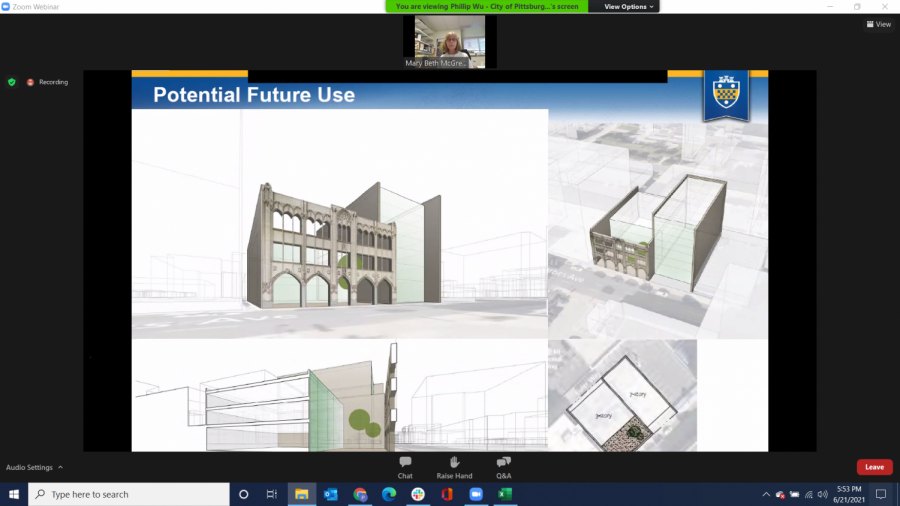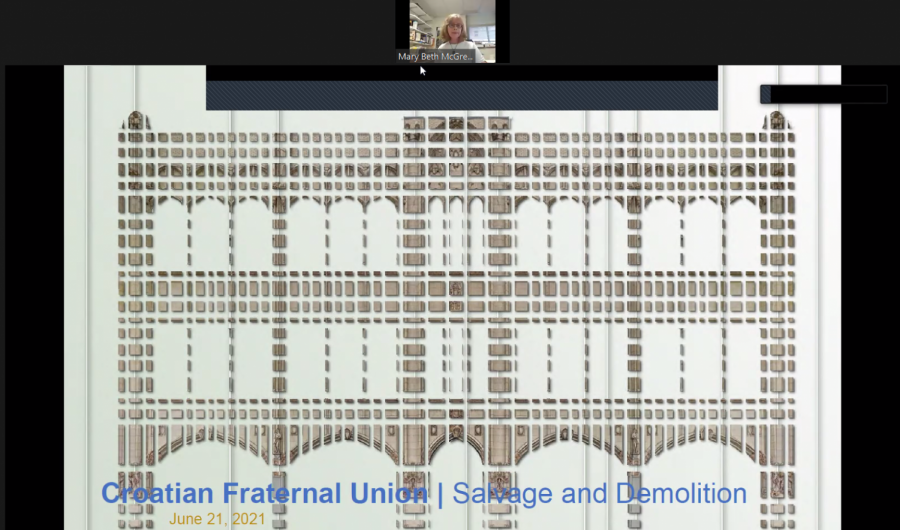OPDC discusses proposed Croatian Fraternal Union building demolition
The Oakland Planning and Development Corp. held a public meeting Tuesday night to discuss neighborhood developments, including a proposal to demolish and refurbish the current Croatian Fraternal Union located on 3441 Forbes Avenue.
June 23, 2021
Those walking down Forbes Avenue may soon not be able to see the familiar historical facade of the Croatian Fraternal Union building.
After severe damage to the structural integrity of the building, Mary Beth McGrew, the associate vice chancellor of planning, design and real estate at Pitt, discussed the University’s plan to demolish the building and salvage parts of its facade for the sake of historical preservation.
“We hope to receive approval for the closure of the site and demolition would be planned to begin immediately following anticipated public approvals, of course subject to building conditions not degrading any further,” McGrew said.
The Oakland Planning and Development Corp. held a public meeting Monday night to discuss the proposal to demolish and refurbish the current Croatian Fraternal Union building at 3441 Forbes Ave. Prior to the University’s 2018 purchase of the building, it was occupied by the Allegheny County Health Department.
McGrew said while some parts of the building are salvageable — including pieces of the terracotta facade and blue fence wrapping around the adjacent lot — the current state of the building has a failing superstructure with a collapsed roof on the uppermost floor. She said the interior conditions of the building are extremely poor with all finishes and partitioning being destroyed and unsalvageable.
McGrew said before the University can move forward with the plans for the building demolition, the team must wait until a July meeting with the OPDC and other community organizations to secure approval.
“We anticipate going to the last July hearing held by the planning commission for demolition and salvage plan approval,” McGrew said. “And then we’ll have a future building and hearing for new development plan approval.”
McGrew also included a sketch of the initial ideas for the remodeling of the building in her presentation. These ideas include leaving a gap in between adjacent buildings for an “open-space feel” and requesting adjacent buildings be no taller than the 85-foot height limit that the historical preservation guidelines designate.

According to McGrew, preserving the historical significance of the building is a top priority, so salvaging the terracotta facade remains an important part of the demolition proposal.
“We want to catalog the terracotta and move them off site in protected climate controlled storage,” McGrew said. “After the site is improved and occupied and the recovered facade is reconstructed, the University then agrees to nominate the recovered facade for individual historic designation exclusive to the new structure.”
Anthony Benvin, a board member of the Preserve Croatian Heritage Foundation, said he, the University and Preservation Pittsburgh came to an agreement on May 5 to preserve the remaining terracotta pieces of the facade for future assembly. Benvin said preserving these pieces has historical importance to the community.
“There was something here to be salvaged,” Benvin said. “And some discussion of the history of the site was important to the City of Pittsburgh and in particular the Oakland community.”
Brian Trimble, a member of the public who was present at the meeting, questioned why the building cannot be refurbished to its original historical accuracy. Trimble said the “facadectomy,” the retention of a building’s facade while renovating its internal structure, seemed to not be considered in the plans.
“It seems as though the remodel of the building is being done in the name of historical preservation,” Trimble said. “But none of the ornamental designs are being kept.”
In response, McGrew said due to the amount of damage to the building, completely restoring or refurbishing the building with historical accuracy would be misleading for the public.
“We talked about rebuilding it exactly quite a bit, but the building has been gone for so long it would seem disingenuous to rebuild it as it once was,” McGrew said.
McGrew said the University’s plans for the interim use of the building post-demolition are to extend the existing blue fence around the site and requested that there be no use of the vacant lot prior to redevelopment of the site.
She added that the University will decide the uses of the building, including who will occupy it, but nothing has been decided just yet. She said the goal of the remodel designs was to put as much back together as possible while still maintaining the genuity of the building.
“So our goal was following the recommendations of historic preservation to look at what is there, and put as much of it back as we can to pique your curiosity,” McGrew said. “And then maybe work with Preservation Pittsburgh on writing about the history of the Fraternal Order and putting that inside that open air space so that people can read about the significance of that, rather than restoring something that wouldn’t be real or genuine.”








